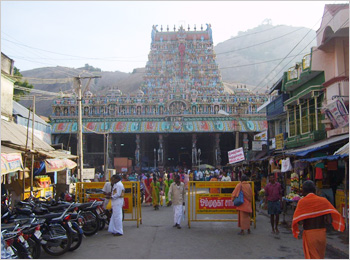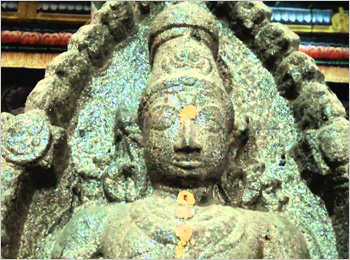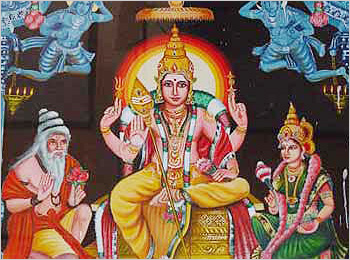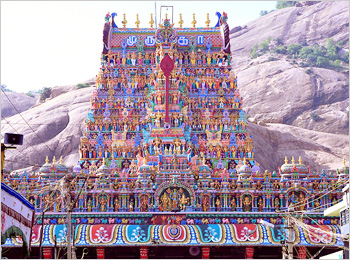- Murugan
Tiruparankunram Murugan Temple
- Thiruparankundram,Tamil Nadu
- View on map
- Tell us about this temple
Overview
The Sri Tiruparankunram Temple is located in Madurai and is dedicated to Lord Muruga. The Temple is an Aru Padaiveedu, which are the six fundamental dwelling places of Lord Muruga. The temple is found five miles away from Madurai. Gnana Sambanda, the renowned Shaiva Saint of the Seventh Century, sang a Devaram on Lord Shiva while passing Thirupparamkunram. The temple is very old. The other Arupadaiveedus that are dedicated to Lord Muruga are in Thiruchendur (100 km south of Madurai), Palani (120 km west of Madurai), Swamimalai (150 km east of Madurai), Thiruthani (50 km from Chennai) and Pazhamudircholai (10 km north of Madurai).
About the Temple

The Sri Tiruparankunram Temple is cut in rock and is massive in size. The temple is where Lord weds Deivayanai. Along with Muruga, idols of Shiva, Vishnu, Vinayaka and Durga are housed. One of the curious things about this temple is that Shiva and Vishnu confront one another in the holy place. Which is a rare happening. This is on the ground that Hinduism has two groups of followers – Shaivites (admirers of God Shiva) and Vaishnavites (admirers of God Vishnu). Outside the temple, there is an excellent lake. Fish in the lake are given salt and puffed rice by devotees. There is a Vedic school beside the lake. This temple was shaped by cutting a hill. In front of the Dwajasthambam or the Kodi Maram, there is a well sculpted Nandi, a Mayil and a Mouse (the vehicle of Ganesha). This is a claim to fame for this temple. There are sannidhis of different Gods and Goddesses. What is most unique is that the sannidhi of Saneeswaran, is seen without the other eight grahas. After a flight of six stages, called the 'Shadashara Padigal', the Ardha Mandapam is situated. There are stone carvings of Mahisshasura Mardini, Karpaga Vinayagar, Andarabaranar and Uggirar. There is also a stone-cut sannidhi for Vishnu and Lakshmi. Shiva is seen as a Sivalingam. The Sathiyagireeshwarar sannidhi in this temple is very appealing The Moolavar idol is moulded from a stone, too. Abhishekams for the idol are also performed to Murugan's Vel. There are five Theerthams around the temple.
It is believed that this temple dates back to the Pandava period. They had a noteworthy influence in building the temple. There are a few inscriptions and scholarly confirmations saying that this temple was built in the seventh and eighth centuries BC. The inscriptional proof points-out that the temple was a Jain temple and then converted into a Murga temple back and forth. Later it was changed again into a Hindu temple and the Minister of the Pandya King, Gajapathy, was involved in this transformation. A Saint in the Seventh Century, Saint Gnana Sambanda spoke about the presence of a Shiva temple in his works. This hill temple is known for its highly renowned structural engineering, and its stone cutting, which draws devotees from all over the world. An astonishing amount of elements of this temple incorporate the art of the Pandya period and life-size figures that it houses are from the Nayakar period. There is an Aasthaana Mandapam. It has beautifully carved column which lead to the Rajagopuram which is 150 feet high. Statues of Vishnu, Shiva, Vinayakar, Durga and Subramanya are cut on the parankundram rock's divider. This temple has a few mandapams that are arranged at different levels. They incorporate the Mahamandapam, the Ardha Mandapam, and the Kambathadi Mandapam.
The celebration of Brahmotsavam is praised in this temple in the month of Panguni as indicated by Tamil Calendar. For the Chittirai celebration, Lord Murugan and Vishnu named as Pavalakanivai Perumal, are taken on a parade to Madurai to observe Meenakshi's wedding. Alternate celebrations that are commended in the temple incorporate Skanda Sashti, Vaikasi Visakam, ten-day long Kartikai Festival and the Thai Coast celebration. Vaikuntha Ekadasi is also celebrated in this temple. It has been mentioned in different established Tamil writings that this is the 'Southern Himalaya' where the divine beings congregate. Tirupparankunram is additionally specified in legend as being the spot where the sun and moon stand. Other than the phenomenal temple for Murugan, there is also a Muslim temple devoted to Sekunder or (al-Sikandar, Alexander the Great) that is connected with Murugan by Muslim pioneers.
About the Deity

The Tamil word Murugu implies energy. He sparkles in each Alankara. He is a ready profound pioneer in Vibuti abishek, a Majestic Subramania in Sandal abishek. Of the six army camp temples (Aaru Padai Veedu) of Lord Muruga, this is the first temple.
Nakkeerar shrine

Celebrated Tamil poet laurate in Pandya's court, Nakkeerar came to this sacred place to perform penance for cleansing himself of the sin of arguing with Lord Shiva in a contest. A leaf in the tank was partially of fish and bird form. As Nakkeerar saw this strange creature, his penance was disturbed. A devil (Bhoodam) had already captured 999 such persons whose concentration was disturbed during Shiva worship. The devil now took Nakkeerar its captive and made the count to 1000 round.
Poet Nakkeerar sang Tirumurugattrupadai in praise of Lord Muruga to save all the prisoners of the devil. This is the invocation song in Pathupattu (10 songs) being the first section of the 18 works of Sangam literature edited as Pathinenkeezhkanakku. Lord Muruga appeared before the poet, killed the devil, and shattered the cave prison with His Vel. The poet expressed his wish to have a dip in the Holy Ganga to wash of the touch of the devil. Lord Muruga pounced on a rock with His Vel. Ganga sprang up. Nakkeerar was happy. This spring, never going dry, is at the top of the hill. Kasi Viswanathar-Visalakshi shrine is near this spring facing west. Muruga Shrine is opposite of this shrine with a place to Nakkeerar. There are sculptures of four Shivalingas, one Shiva idol, Kasi Viswanatha, Subramaniar, Ambica, Bhairava and Karpaga Vinayaka. The Panchakshara cave where Nakkeerar was locked up by the devil and Saravana Poigai are near this shrine.
9 soldiers
When Lord Shiva created Muruga from the sparks of His eye, unable to bear the heat, Mother Parvathi ran from the place, when Her anklet broke. From the pearls, came nine Shaktis called Nava Kalis. These women loved Lord Shiva and became pregnant. Knowing this, Parvathi cursed them to live with their pregnancy. The Navakalis appealed to Lord Shiva for a remedy. Lord Shiva made a compromise with Parvathi saying that they should deliver for the welfare of the world and to help Lord Muruga in his war to kill demon Surapanma. Parvathi agreed. They delivered 9 male children named Veerabagu, Veerakesari, Veera Mahendran, Veera Maheswaran, Veera Rakshan, Veera Marthandan, Veerandhagan, Veeradheeran and Veera Suran. There is a separate shrine for these nine heroes in the front hall mandap in the temple.
Garuda near Lord Muruga
The vehicles of the Lords bull of Shiva, mouse of Vinayaka, peacock of Muruga are in front of the respective shrines in the temples. Here, these vehicles are by the side of the flag post-Kodimaram, facing south. The eagle vehicle of Lord Vishnu, Garuda is in the Karthikai Murugan shrine in Shanmuga mandap as Lord Vishnu shrine is opposite of Lord Shiva.
White peacocks
We know peacocks in their natural colours only. White peacocks can be seen in Tiruparankundram. According to tradition, the Devas are here in the form of white peacocks to worship Lord Muruga.
Rudrabishekam to Lord Dakshinamurthy
Lord Dakshinamurthy graces with His left hand on a snake under His feet. Those afflicted with bad effects in their horoscopes, those suffering from prolonged illness offer Rudrabisheka worship in the shrine. They personify Lord Dakshinamurthy in a silver pot and engage Vedic scholars to chant the powerful and effective Rudra, Chamaha mantras for relief. The worship yields huge benefits to the devotee.
Devi Lingam
While Lord Shiva was teaching the Pranava Mantra to Mother Parvathi, Muruga sitting on the lap of Mother also was also listening. Any lesson should be learnt from the Guru in a proper way. To make amends for the mistake, Lord Muruga performed penance here. Lord gave darshan to His beloved Son on a Thaipoosam day. This Shiva shrine is in a separate shrine in the name of Aadhi Sokkanathar. Those visiting Tiruparankundran should worship this Shiva first according to tradition. But as the temple is the first army camp temple of Lord Muruga, traditions changed in later days.
During the festival times, flag hoisting is done only for Lord Shiva, but Lord Muruga is taken in procession. As Lord Muruga is no less than Lord Shiva, it is said that this procedure is followed. Lord Muruga is also known here as Somasubramaniar (Soma-Shiva, Subramaniar-Muruga). Lord Muruga graces as Somaskanda with Shiva and Parvathi in the sanctum sanctorum behind the Shivalinga. It is also said that Lord Shiva graced Durga granting Her relief from a curse. As this Shivalinga was installed by Durgadevi, the Linga is known as Devi Lingam. As the Linga is treated with a paste called Shantakaram, no abishek is performed to Him except offering oil. Sages Veda Vyasa and Parasara had worshipped in this temple.
This is the temple graced by five deities, Shiva, Pavalakanivai Perumal (Vishnu),Karpaga Vinayaka, Subramaniar and Durga. Mother Durga is in north of the Main Tower-Rajagopuram- demon Mahishasura under Her feet. Left of Durga is Karpagavinayaka holding a stick of sugarcane, sitting on a lotus with sages around Him. Right of Durga is Lord Muruga in a wedding pose with Deivania facing north. Narada, Indira, Brahmma, Saraswithi without Her Veena and SAvithri are also here by Murugas side. Lord Shiva in the sanctum sanctorum is facing east. Sage Madanga Mahrshi is by His side. Lord Vishnu is in the place of Nandhi the bull vehicle of Lord Shiva. Hence, the temple is known as Mal Vidai (Mal-Vishnu, Vidai-bull) temple and this is a very rare design. It is said that Lord Vishnu is serving His Brother-in-law.
Sathyagiriswarar
Demon Mahishasura was harassing the Devas in many ways. Mother Ambica took the form of Navanayakis, fought with him and destroyed him on the ninth day. The killing of the demon brought her the Brahmmahati dosha. She worshipped Lord Shiva for release from the sin. Lord advised Her to worship Him from here for result. Ambica followed Lords advice and worshipped installing a Linga on the mount which itself was but a Linga. Shiva granted darshan to Durga and relieved her of the dosha.
Today too, the presiding deity is Lord Shiva only in the temple. He graces from a Kundru - Mount, and is praised as Parankundranathar and the place Parankundram. He is also praised as Sathyagiriswarar. As it is here that Lord Muruga married Deivanai, importance is more attached to Lord Muruga and the temple became Muruga Temple in the days that followed. On the full moon day poornima in Aani month (June-July) three fruits mango, plantain and jack are offered to the Lord with special pujas.
Nandi with His consort
Nandi, the bull vehicle of Lord Shiva graces with His consort Kalakandi in the Maha Mandap of the temple. There are twin Vinayakas by His side. While there will be prakaras-corridors in the temples with other deities, Tiruparankundram temple is different without these formalities. As the Mount itself is in the form of a Linga, only Girivalam is possible. In Pillayarpatti, though the temple is the cave type, there are prakaras within the temple.
Correcting the mistake
When Lord Shiva was teaching Pranava Mantra to Mother Parvathi, Muruga being there, also listened and learnt the Mantra. As it was against the rules, Muruga wished to correct Himself of the mistake, performed penance here seeking Lords pardon. Lord Shiva graced His darshan to the Beloved Son on a Thaipoosam day. He graces as Aadhi Sokkanatha from a shrine opposite to the Subramaniar temple. According to tradition, those visiting Tiruparankundram should worship here first before proceeding to the present main temple.
The Son in place of the Father
During the festivals, flag hoisting is performed for Lord Shiva only while Lord Muruga is taken in procession. As Muruga is not different from Shiva, this procedure is followed. Muruga also bears the name Somasubramaniar representing both Shiva and Muruga. While Durga is a sub-deity in other temple, she has her own Kodimaram (Flag Post) and a Main Tower-Rajagopuram in this temple. After killing Mahishasura, Mother Durga worshipped Shiva installing a Linga also here. Lord Shiva graced Her with His darshan and asked Her to stay in Tiruparankundram itself. Hence, more importance is attached to Mother Durga.
Nandi
The size of Nandi in Bragadeeswarar temple in Thanjavur and Gomukteeswarar temple in Tiruvavaduthurai are big in size corresponding to the size of Lord. As Shiva is in the form of a mount, the Nandi here too is big. He is gracing with His consort Kalakandi. There are twin Vinayakas by his side. As the mount itself is considered as Vimana, there is no such a structure above the sanctum sanctorum. Girivalam (going around the hill) is followed on Full Moon days Poornima.
Legend and Stories
Long ago, when God Subrahmanya was staying at Kanda Verpu, the two little girls of Lord Maha Vishnu, Amrita Valli and Sundara Valli, treasured the yearning of turning into Subrahmanya’s consorts. In light of this point, they went to Saravana Poigai. They undertook penance. Their prayers were satisfied with their request to the Lord. Lord Subrahmanya showed up before them and told Amrita Valli, ''You will be raised by Indra as his girl. I will wed you at the appropriate time.'' Her youthful sister Sundara Valli, was additionally graced with a comparative gift. She was destined to marry Sage Sivamuni and was raised by Nambi. Amrita Valli took the type of a woman and went to Mount Meru, the house Indra. He said, ''I am the daughter of Maha Vishnu and the obligation of taking care of me has been endowed to you.'' On listening to this, Indra turned out to be exceptionally glad and coordinated Airavatam, his white elephant, to deal with the youngster.
The elephant with all admiration brought her up. She got married in due course of time. Consequently, she came to be known as Devayanai, meaning the one who was raised by the sublime elephant of Indra (yanai in Tamil means elephant).The six children of Sage Parasara were reviled to end up as fish in the Saravana Poigai. On solicitation for their recovery, these six young men were requested to appeal to Lord Subrahmanya. When they got his darshan, they could recover. It was made known that Lord Subrahmanya would come to Tirupparankunram in the wake of vanquishing the devil, Surapadma. Restlessly, they sat tight for the landing of Subrahmanya. When Subrahmanva’s mission to vanquish Surapadma was over at Tiruchendur, these circumstances ensued.
When he landed in Tirupparankunram, the children of Parasara got Subrahmanya. At their solicitation, he agreed to stay there. He asked Viswakarma to build a delightful house himself for the devas, and others. He recommended to the magnificent modeller to construct streets and erect a city around them. Indra, the Lord of the Holy Messengers, got his little girl Devayanai married to Subrahmanya as a sign of his appreciation for releasing himself and the devas from the evil presence's ravaging ways. He spoke to Brahma and Vishnu about his desires, and they were excessively happy. When they told Subrahmanya about Indra’s yearning, he promptly said: ''Devayanai has been begging at Saravana Poigai in the Himalayas for this cheerful marriage. Presently the time has wanted it being solemnized.'' As Subrahmanya consented to this marriage, Indra sent an ambassador to bring his wife Indrani and daughter Devayanai from Mount Meru. The marriage occurred at Tirupparankunram after the triumph of Subrahmanya over Surapadma. All plans for the marriage were made and the marriage was performed at the Temple. Every one of the devas, Siva and Parvati went to the wedding and blessed Subrahmanya and Devayanai.
Festivals
There are 25 festivals in this temple in a year:
1. Tamil New Year day April
2. Chitra Festival April
3. Vaikasi Visakam June
4. Mottaiarasu vizha June
5. Ani Voonjal July
6. Ani Muppzha Poojai July
7. Adipooram July-August
8. Adikarthigai July
9. Vinayagar Chathurthi September
10. Avani Moolam September
11. Navarathiri October -November
12. Saraswathi poojai October -November
13. Vijayadasami October -November
14. Iyappasi Pooram October -November
15. Sri skantha sasti October -November
16. Karthigai somavaram November-December
17. Thirukarthigai November-December
18. Marghazhi poojai December-january
19. Arudra Darisanam December-January
20. Vaikunda Ekadasi December-January
21. Theppam Festival January - February
22. Thai Poosam January - February
23. Masi Mahasivarathiri January - February
24. Sri Veyilukanthamman festival February
25. Panguni Peru Vizha March -April.
Pooja Timings
There are eight times in a day when poojas are done. These timings are as follows:
|
S.No |
Pooja Name |
Time |
|---|---|---|
|
1 |
Thiruvananthal |
5.30 A.M |
|
2 |
Vizha Poojai |
7.30 A.M |
|
3 |
Kalasanthi |
8.00 A.M |
|
4 |
Thirukaka santhi |
10.00 A.M |
|
5 |
Uchikalam |
12.00 P.M |
|
6 |
sayaratchai |
5.30 P.M |
|
7 |
Artha Jamam |
8.45 P.M |
|
8 |
Palliyarai |
9.00 P.M |
Offerings
Devotees undertake feeding the poor (Annadhanam) as prayer commitment.
Social Services
Karunai Illam is an orphanage run by the temple. It offers free boarding, lodging and education facilities to 125 children from the temple funds. Free marriages are conducted for the poor and Adi Dravida people. It costs about of Rs. 3000/- per couple from the temple funds.
Religious Activities
Religious discourses are conducted every day, in the evenings. Thirukkural classes are conducted every Sunday, between 10.00 AM and 11.00 AM. In addition, there are also religious education classes every Sunday between 11.00 AM and 12 Noon.
Rare Facts
A fascinating part of this temple is that it is shaped on a slope like that of the Ajantha and Ellora Caves. This is the only temple where Lord Subramanya is seen in a seated posture. He is accompanied by Goddess Deivayanai in the wedding scene. He has Naradhar, Lord Brahma and Goddess Saraswathi in a standing posture and on the upper side. The Sun, the Moon and the Devas offer a rare darshan. Being a cave temple, no abhishekam is done for the main deity. Only a thailakappu is done, where punugu is pasted.
Significance
Those facing obstacles in wedding alliances and risk to the welfare of their children pray here. They also light lamps in the Durga shrine during the Rahu Kala time each day.
Praise for the Temple
The temple and the Lord and Gods in the temple are praised by renowned saints and poets such as Nakkeerar, Arunagirinathar, Pamban Swamigal, Tirugnanasambandar, Tirunavukkarasar, Sundarar and Manickavasagar.
Nearby Places to Visit
The Arulmigu Meenakshi - Sundareswarar Temple and the Thirumalai Nayak Palace are ideal places one can visit nearby. The temple is open for visitors between 9.00 AM and 1:00 PM, and again, between 2:00 PM and 5:00 PM. The entry fee for visitors is Rs.1. There is also the Koodal Azhagar Temple, which is a famous temple dedicated to Lord Vishnu. It is located in the center of the City of Madurai. Koodal is another name for Madurai and Azhaghar means ‘the beautiful one,’ in Tamil. The temple is ancient and very close to the Meenakshi Amman Temple. It is one of the 108 divyadesams, i.e., the holy abodes of Vishnu. Another area to visit would be the Alagar koil, which is about 21 kilometers to the North East of Madurai. The temple is situated on a hill amidst panoramic surroundings, and the hill on which it is located is called Solaimalai. The temple has beautiful carvings and makes a visit rewarding. Palamudirsolai, one of the six abodes of Lord Subramaniya is located atop the Hill.
In addition to the temples, one may also choose to visit the Gandhi Museum. It is open from 10.00 AM to 1.00 PM, and from 2.00 PM to 5:30 PM. It is open on all days. Housed in the old Palace of Rani Mangammal, the Gandhi Museum depicts the highlights of the Indian Struggle for Independence, and contains a picture gallery of the Gandhian movement. One can also see a gallery of relics, Khadi and village industries, alongside a separate section on South Indian Handicrafts. The Mariammman Teppakulam is another interesting site – comprising a beautiful square tank which is spread over a huge area of almost sixteen acres, located about five kilometers to the east of the Meenakshi Temple. The tank is the scene of a colourful float festival that is held annually in January and February, to celebrate the birth anniversary of King Thirumalai Nayak who built this tank. The deities of Meenakshi and Sundareswarar are placed in a float, called “Teppam”, decorated with flowers and illuminated with hundred of lights. This float is taken around the tank to the sound of traditional music. On the Northern side of the tank a temple is dedicated to Mariamman, a famous village deity of Tamil Nadu.
Accessibility
Airport
Madurai is the nearest air terminal. It is about ten kilometres in the South East direction, and is connected by flights from all over the country.
Railways
The city is about eight kilometers, away from the Madurai Railway junction and the Periyar bus stand in the south west. Thiruparankundram Railway Station is situated between Madurai and the Thirumangalam Railway Stations, on the Chennai -Kanyakumari Railway Track.
Road
Buses are available from the Madurai Periyar bus stand. All buses moving from Periyar to Thirumangalam go through Thiruparangunram.
Temple Address
Arulmigu Subramaniaswamy thirukovil,
Thiruparakundram, Madurai,
TamilNadu, India,
Pincode - 625 005.
Significance
Devotees visit this temple to seek fulfillment of the following:-
- Marriage alliances
- Welfare of children
Shlokas
Shadaananam Chandana Liptha Gathram Mahorasam Divya Mayoora Vaahanam Rudrasya Soonum Suraloka Naatham Brahmanya Devam Charanam Prapadye
Meaning -I always take refuge in the 6 faced Lord Guha, who has sandal paste smeared over his body, who is broad-chested, whose vehicle is the peacock, who is Lord Shiva's son and who leads the army of the Devas.
Heyswami Natha Karunakara Dheenabandho Shree Parvatheesha Mukha Pankaja Padmabandho Shree Saadhi Devagana Poojitha Padha Padma Vallesa Nadha Mama Dehi Karaavalambham
Meaning -O! Merciful Lord Swaminatha, who cares for the poor, who is the sun to Lord Shiva's lotus face, whose lotus feet are acknowledged by Lord Vishnu and the others, Valli's Lord, please uplift me by lending me your hand.
Ariru Thadanthozh Vazhga Arumugam Vazhga Veppai Kooru Sei Thanivel Vazhga Kukkudum Vazhga Sevvel Yeriya Magnai Vazhga Aanai Thun Anangu Vazhga Maarila Valli Vazhga Vazhga Seer Adiyar Yellam
Meaning -Oh Muruga, we hail your 12 strong shoulders for they protect us from our enemies, we hail your 6 faces, we hail the Vel, your weapon that broke apart the Krounja mountain to reveal the asura in it. We hail the bird, the cock, that is part of your symbol in the flag. We hail your peacock, that takes you all over the world, we hail your consort Devyani, who was brought up by Indra's white elephant, Airavadam, we hail your other consort, the flawless Valli. And we hail your Bhaktas who worship you as a prayer.
Uruvai Aruvai Uladhai Iladhai Maruvai Malarai Maniyai Oliyai Karuvai Uyirai Gadhiyai Vidhiyai Guruvai Varuvai Arulvai Guhaney
Meaning -O Lord Muruga, you have form and you are formless, you have everything and have nothing, you who exist in the smallest, in flowers, in a bell's ring, in the light. You are the embryo, the life, destiny and fate. Bestow your blessings on us as our guru.
Timings
Morning – 5:00 a.m. to 1:00 p.m.
Evening – 4:00 p.m. to 9:00 p.m.
